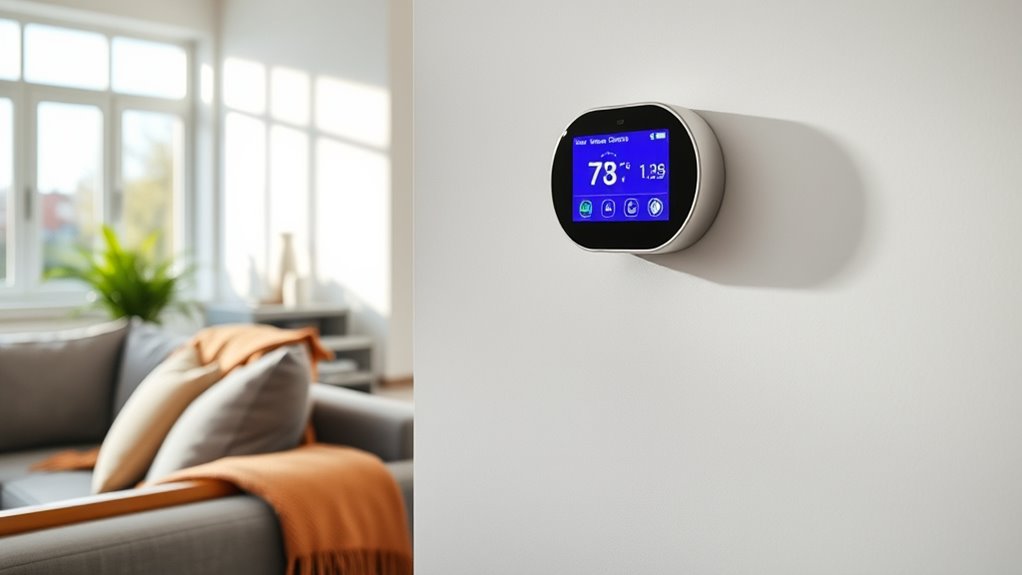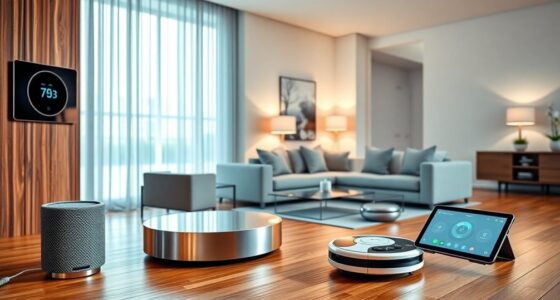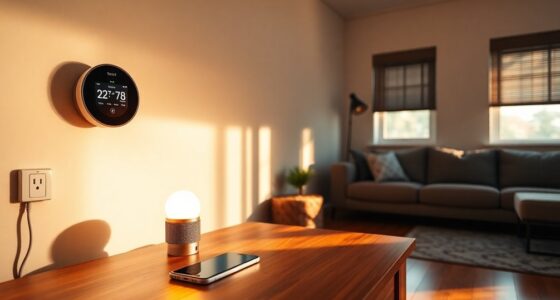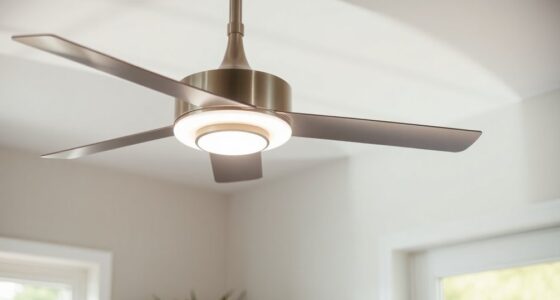To save money with your smart thermostat, set different temperatures for day and night, lowering the heat during sleep hours and rising it when you’re awake. Use eco or energy-saving modes when you’re away or sleeping, and create a consistent weekly schedule to optimize performance. Leverage geofencing to adjust settings based on your location and customize smart away modes for increased efficiency. Keep fine-tuning your temperature differentials to maximize savings—more tips await if you continue exploring.
Key Takeaways
- Activate eco or energy-saving modes during absences and nighttime to reduce energy consumption.
- Use geofencing to automatically adjust temperatures based on your smartphone’s location.
- Set consistent weekly schedules with optimized temperature differentials to prevent unnecessary system cycling.
- Gradually lower or raise the temperature during sleeping hours and daytime to maximize savings without sacrificing comfort.
- Regularly review and tweak settings for humidity, air quality, and temperature gaps to enhance efficiency and indoor comfort.
Adjusting Your Temperature Settings for Different Times of Day

To make the most of your smart thermostat, it’s important to adjust your temperature settings throughout the day. Start by lowering the temperature during your sleeping hours to save energy, then raise it when you wake up. During work hours, set a comfortable temperature to prevent unnecessary heating or cooling. Incorporate humidity control to maintain ideal comfort and air filtration to improve indoor air quality. Keeping humidity levels balanced helps prevent mold and keeps your home feeling fresh. Adjusting these settings based on your daily schedule ensures your system isn’t working overtime, which saves money. Remember, smart thermostats can learn your routines, so take advantage of this feature to fine-tune your temperature adjustments effortlessly. Properly managing these factors enhances comfort and promotes a healthier indoor environment. Additionally, optimizing your settings can contribute to energy efficiency by reducing unnecessary system operation, which aligns with the benefits of smart thermostat features.
Utilizing Eco or Energy-Saving Modes Effectively

Using eco or energy-saving modes can considerably lower your energy bills, but only if you activate them at the right times. You should turn them on during absences and adjust settings for nighttime comfort to save energy without sacrificing sleep. Customizing your eco schedules helps you optimize efficiency while maintaining a comfortable home environment. Additionally, understanding signs of spoilage in your appliances can help prevent energy waste and ensure your system operates smoothly.
Activate During Absences
When you’re away from home, activating eco or energy-saving modes on your smart thermostat can substantially reduce energy consumption and save money. These modes help maintain ideal humidity control, preventing excess moisture that can harm air quality. By lowering the heating or cooling, you avoid unnecessary energy use while still keeping your home’s environment safe. Some smart thermostats automatically adjust settings to preserve color accuracy, ensuring your home remains comfortable and healthy during absences. This prevents issues like mold growth or stale air buildup. Make sure your thermostat is configured to activate these modes when you’re away, so you don’t waste energy unnecessarily. Properly utilizing these settings balances cost savings with maintaining a healthy, comfortable indoor environment even when no one is home.
Adjust for Night Use
Are you making the most of your smart thermostat’s eco or energy-saving modes overnight? If not, you might be sacrificing nighttime comfort and sleep quality. Set your thermostat to a lower temperature during sleeping hours, but don’t go so low that it disrupts your rest. Use eco or energy-saving modes to maintain a comfortable sleep environment while reducing energy use. These modes adjust your heating or cooling gradually, helping you stay cozy without waste. Keep in mind that a slight temperature decrease can promote better sleep without feeling chilly. Be sure to review your thermostat’s settings regularly to ensure they’re optimized for your comfort and savings. Properly adjusting for night use helps you get restful sleep while saving money on your energy bill. Additionally, understanding how workaholic tendencies can impact your energy management may encourage you to set boundaries that prevent overuse of heating or cooling when not needed.
Customize Eco Schedules
To get the most benefit from your smart thermostat’s eco or energy-saving modes, you should customize your schedules to match your daily routine. Set your thermostat to lower or raise temperatures during times when you’re typically away or asleep, maximizing savings. Conduct energy audits to identify areas where insulation upgrades could further improve efficiency, reducing the workload on your thermostat. Decluttering your space can also improve overall home efficiency by allowing better airflow and temperature regulation, leading to more effective heating and cooling. Adjust eco schedules accordingly once upgrades are complete, ensuring your system operates fundamentally well. Many thermostats allow you to create different schedules for weekdays and weekends, so you can fine-tune your energy use. By aligning your thermostat settings with your lifestyle and home improvements, you’ll reduce energy waste and save money without sacrificing comfort.
Setting a Consistent Weekly Schedule
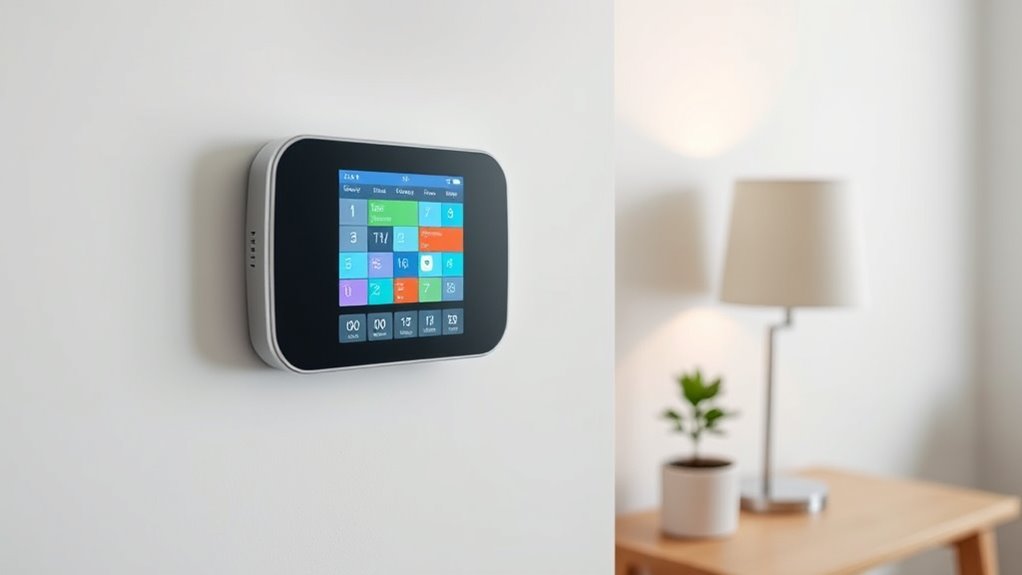
Setting a consistent weekly schedule helps you stay comfortable and save energy. You’ll want to establish temperature targets for each day and adjust them for daylight changes. This way, your thermostat works efficiently without constant manual adjustments. Incorporating energy-saving techniques into your routine can further optimize your utility bills.
Set Weekly Temperature Targets
Have you ever considered how a consistent weekly schedule can maximize your smart thermostat’s performance? Setting weekly temperature targets helps maintain humidity control and air quality while saving energy. By establishing specific temperatures for different times, you prevent unnecessary heating or cooling. Here’s a simple example:
| Day | Morning | Afternoon | Night |
|---|---|---|---|
| Monday | 70°F | 75°F | 68°F |
| Tuesday | 70°F | 75°F | 68°F |
| Wednesday | 70°F | 75°F | 68°F |
| Thursday | 70°F | 75°F | 68°F |
| Friday | 70°F | 75°F | 68°F |
This consistency ensures maximum comfort, improves air quality, and helps control humidity, ultimately saving you money. Establishing smart thermostat settings is also crucial to optimize energy efficiency.
Adjust for Daylight Variations
Adjusting your thermostat for daylight variations guarantees your home stays comfortable without wasting energy. As days lengthen or shorten, tweak your schedule accordingly to optimize energy use and maintain comfort. If you have solar panel integration, align your heating and cooling to maximize solar energy, reducing reliance on grid power. Incorporate humidity control techniques to prevent excess moisture during humid months, which can make indoor temperatures feel warmer or cooler than they are. Consistent weekly scheduling helps your smart thermostat adapt to natural light changes, avoiding unnecessary temperature fluctuations. Regularly updating your energy-saving strategies ensures your home remains cozy while saving money. Staying mindful of daylight shifts also supports energy efficiency, especially when paired with smart features like solar integration and humidity control.
Leveraging Geofencing to Optimize Comfort and Savings
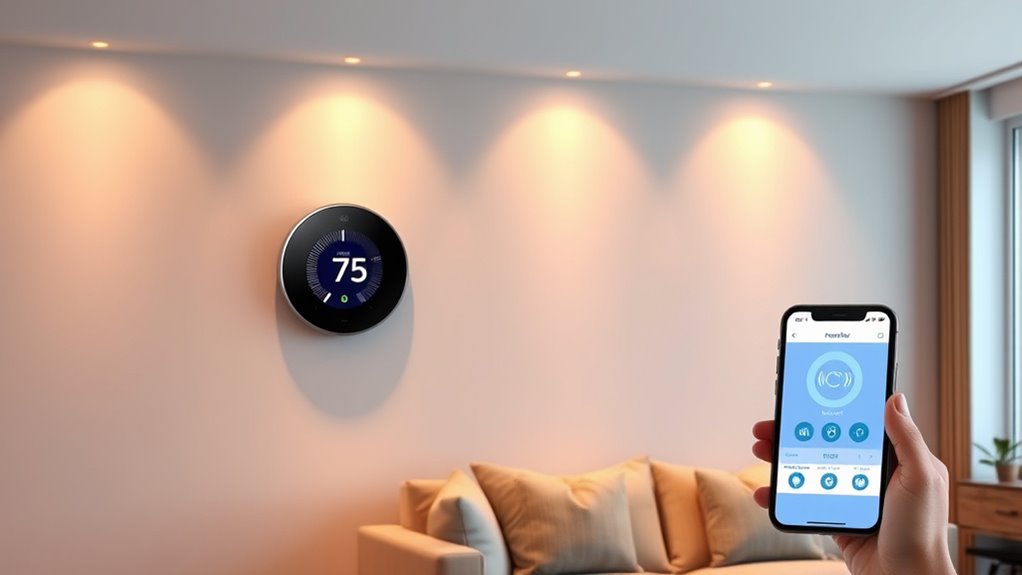
By using geofencing technology, you can automatically tailor your thermostat’s settings based on your smartphone’s location, ensuring your home is comfortable when you arrive and energy-efficient when you’re away. This form of location based control detects your proximity to home, adjusting the temperature accordingly. With geofencing technology, you don’t have to manually change settings or worry about wasting energy when you’re not there. It’s a seamless way to optimize comfort and savings. When you’re nearby, your thermostat can warm or cool your home to your preferred temperature. When you leave, it can reduce energy use. This smart feature helps you save money without sacrificing comfort, making your home more efficient and responsive to your daily routines. Additionally, integrating smart utilities can further enhance your home’s energy management and efficiency.
Taking Advantage of Smart Away and Home Modes
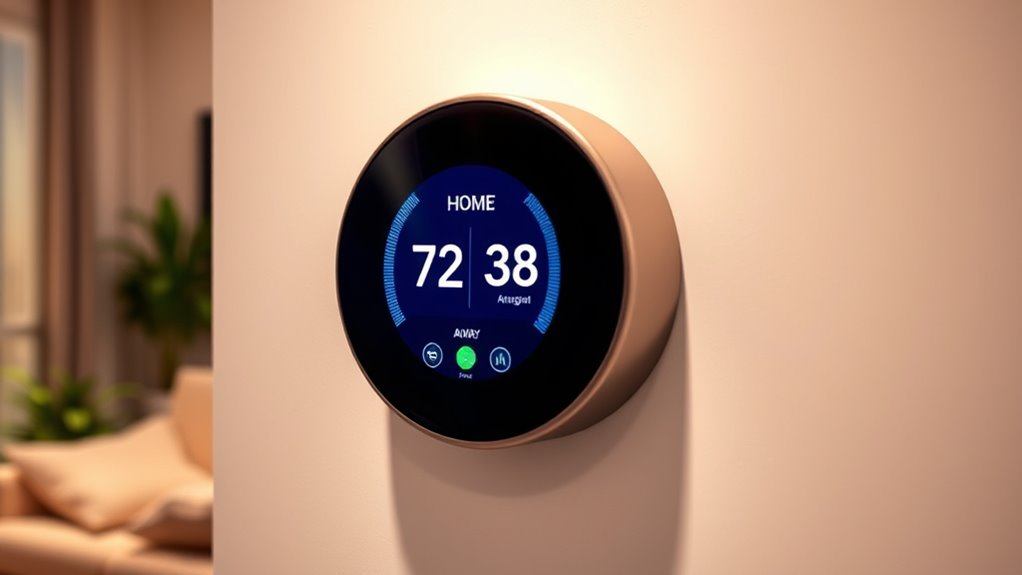
Smart Away and Home modes enable your thermostat to automatically switch between energy-saving and comfort settings based on your occupancy, helping you optimize energy use without constant manual adjustments. When you’re away, these modes lower heating or cooling, reducing energy waste, while at home, they restore comfort settings. Take advantage of humidity control features during these *changes* to prevent excess moisture or dryness, maintaining a healthy indoor environment. Ventilation management is also enhanced, as your thermostat can improve airflow and air quality when you’re present, and minimize unnecessary ventilation when you’re away. By leveraging these modes effectively, you *guarantee* your home stays comfortable and energy-efficient, saving money without sacrificing comfort or air quality. Proper use of Smart Away and Home modes maximizes your thermostat’s potential. Additionally, understanding AI security vulnerabilities can help ensure your smart home devices remain protected against cyber threats.
Fine-Tuning Temperature Differentials for Maximum Efficiency
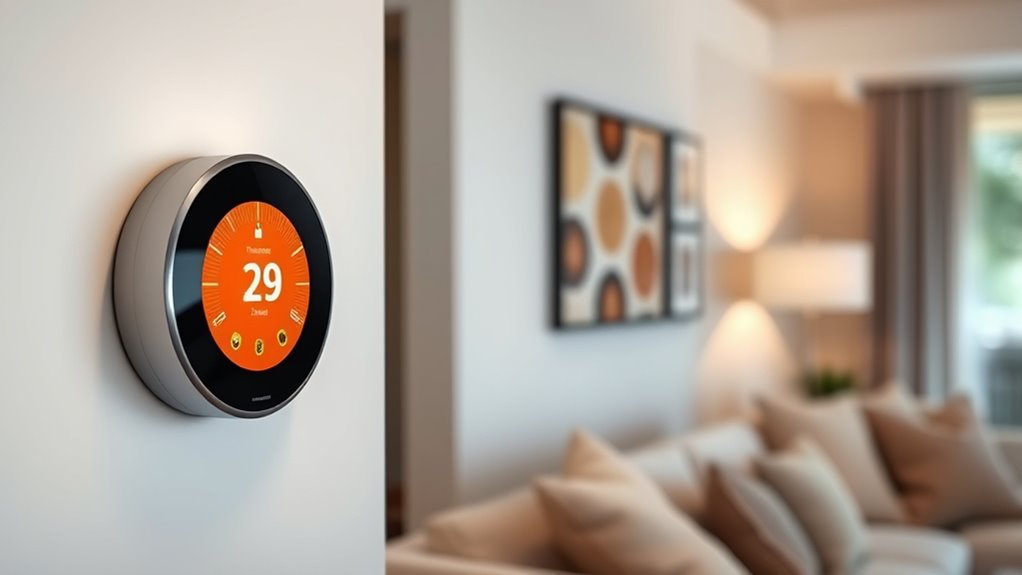
Fine-tuning the temperature differentials on your thermostat can considerably boost your energy savings while keeping your home comfortable. Adjusting the differential settings controls how much the temperature can fluctuate before the system turns on, preventing constant cycling. This not only conserves energy but also enhances humidity control, reducing excess moisture that can affect air quality. Maintaining ideal humidity levels helps prevent mold growth and improves indoor air quality, making your home healthier. Be mindful to set appropriate temperature gaps for heating and cooling to avoid overworking your system. Small adjustments can make a big difference, balancing comfort with efficiency. Regularly review and tweak these settings to ensure your thermostat works efficiently, saving you money without sacrificing a comfortable indoor environment.
Frequently Asked Questions
How Often Should I Update My Thermostat Settings for Optimal Savings?
You should update your thermostat settings seasonally to maximize savings. Make seasonal adjustments when temperatures change to keep your home comfortable and energy-efficient. Also, check your thermostat calibration at least once a year to guarantee accuracy, which helps prevent energy waste. By regularly adjusting for seasons and maintaining proper calibration, you optimize your system’s performance, lowering energy costs and enhancing comfort throughout the year.
Can Smart Thermostats Learn My Preferences Automatically Over Time?
Yes, smart thermostats can learn your preferences automatically over time. Using advanced learning algorithms, they analyze your daily routines and adjust settings accordingly. This means you don’t have to manually program your thermostat constantly; it adapts to your schedule, optimizing comfort and energy savings. Over time, the device becomes more accurate at predicting your needs, making your home more comfortable and saving you money without constant input.
What Are Common Mistakes to Avoid When Setting Temperature Schedules?
Oh, the joys of setting temperature schedules—like a thrilling game of manual overrides and unpredictable temperature spikes! You’ll want to avoid sticking to rigid schedules that ignore your actual comfort. Don’t forget to account for sudden weather changes, which can cause temperature spikes. Also, resist the urge to ignore your thermostat’s learning curve; it adapts better when you let it, saving energy and your sanity.
How Do Smart Thermostats Impact My Energy Bills Long-Term?
Smart thermostats can substantially impact your energy bills long-term by reducing overall energy consumption. They optimize your heating and cooling schedules based on your habits, ensuring you’re not wasting energy when you’re away or asleep. This smart adjustment leads to consistent cost reduction over time. By maintaining efficient temperature control, you save money without sacrificing comfort, making your home more energy-efficient and cutting down on unnecessary expenses.
Are There Compatibility Issues With Certain Home Heating or Cooling Systems?
Think of your home system as a puzzle—compatibility concerns can make fitting a smart thermostat tricky. Some systems, especially older or incompatible models, face system limitations that hinder setup or performance. I once helped a friend install a smart thermostat, only to find out her old furnace didn’t support it. Before buying, check your system’s compatibility to avoid surprises and guarantee smooth operation.
Conclusion
Just like a skilled conductor guides an orchestra, you can harmonize comfort and savings with smart thermostat settings. By adjusting temperatures thoughtfully throughout the day, using eco modes, and leveraging smart features, you orchestrate a symphony of efficiency. Think of your home as a well-tuned instrument, responding seamlessly to your needs. With these simple steps, you’ll master the art of savings—turning your thermostat into a silent, powerful ally in your quest for comfort and cash.
